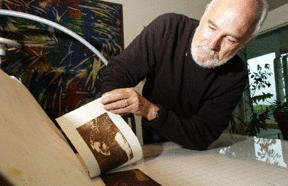Richard Nelson’s dining room table would not have existed just a few years ago.
Print-maker Nelson’s “table” – the 31-inch Whelan etching press in the center of his dining room – would have would have been the source of toxic fumes and vapors that have relegated print-making equipment to the farthest corner of artists’ studios.
But the quiet revolution in print techniques over the last half-decade has seen the introduction of non-toxic materials. Nelson demonstrates his innovative use of the materials at the May 5 ArtsWalk.
“I use all Daniel Smith water-soluble relief inks made for woodblocks,” Nelson says, “and I’m using it in new ways.”
Nelson became aware of work-environment hazards during his years as a commercial fisherman and then as skipper of University of Southern California’s marine science research vessel.
“Working on a boat, you’re always exposed to hazardous materials, from asbestos in the engine room to two-part epoxy paints,” Nelson says.
His job also introduced Nelson to the pleasures of art-making, however.
When the inner-city kids Nelson worked with on the boat in such projects as plankton-collecting made posters at the end of their voyage, Nelson found t heir art inspiring.
“When they did posters, we got these incredible images,” Nelson says. “I realized that art is a way of wrapping your arms around life – a wonderful way.”
When Nelson retired and moved to Bainbridge seven years ago with his wife, Judy Nelson, he was inspired to make his own art – although print-making, with its long list of toxic chemicals, didn’t initially interest him.
But when Nelson took a job with Seattle art supply purveyor Daniel Smith – rising swiftly through the ranks to become the company’s first liaison to art educators and institutions – his attention turned to finding and introducing non-toxic materials.
Now, Nelson and partner Beth Dunn are helping Port Townsend’s Centrum facility convert from acid-based printing to non-toxic image-making. The pair also teach non-toxic materials workshops to Centrum artists.
“Printers are exposed to hydrochloric, sulfuric and nitric acids,” Nelson says. “They use toluene, benzene and xylene solvents. Many are known to be carcinogens. I’ve run into dermatitis among print-makers, nervous disorders – you name it. Traditional print-makers are indeed a dying breed.”
Scanning images into computers and using sunlight to etch steel plate are just two of the host of new ways to make prints.
“The trend to convert to non-toxic printing has been going on for a decade, but over the last three years, the wave has begun to break,” Nelson says. “The results are great.
“Printmaking isn’t suffering; it’s opening up.”
* * * * *
Print-maker Richard Nelson demonstrates environmentally responsible etching techniques from 11 a.m. to 5 p.m. May 5 at Flowering Around in the Winslow Mall. The event is part of “The Artist’s Palette,” the spring ArtsWalk sponsored by BIAHC. Information: 842-7901.



